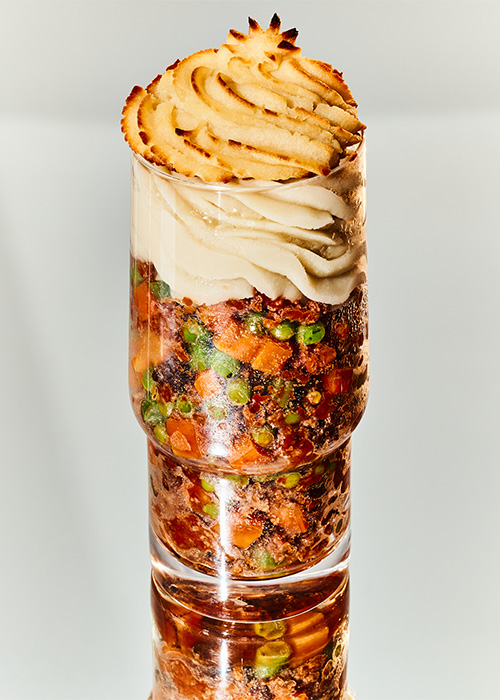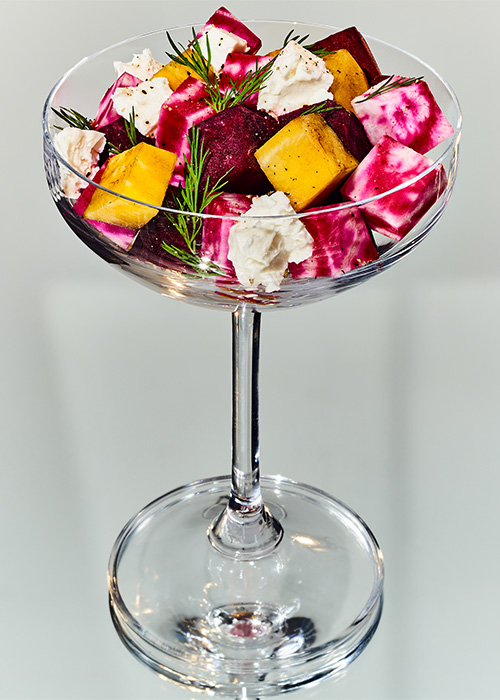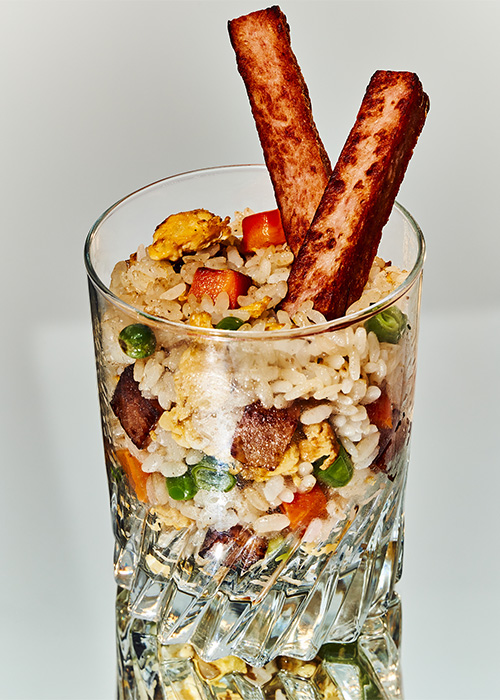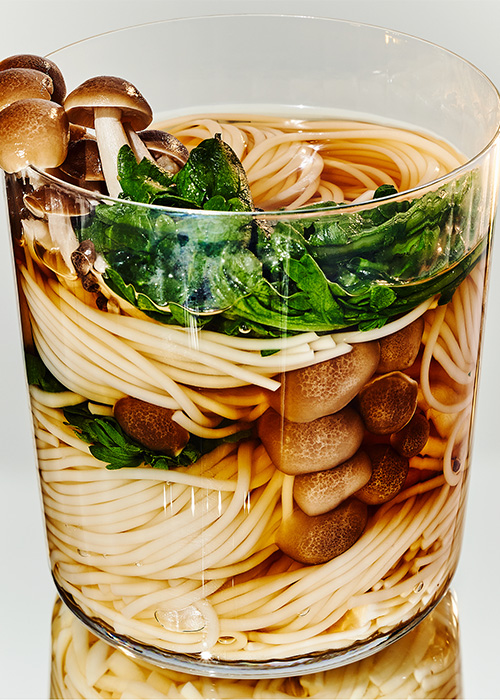There’s a popular place on New York City’s Lower East Side right now that is a destination for some of the most iconic dishes ever to emerge from the world’s kitchens. There, you can order superior examples of the Waldorf Salad, French Toast, and Red Eye Gravy.
There’s only one catch. They all come in liquid form.
The place in question is Double Chicken Please which, in its three-year existence, has emerged as one of the most acclaimed cocktail bars in the world. And its calling card is drinks designed to taste like familiar foods.
Don’t Miss A Drop
Get the latest in beer, wine, and cocktail culture sent straight to your inbox.
Double Chicken Please is the leader in this subgenre of craft cocktails, but it is by no means alone. In the last few years, cocktails that mimic the flavors of specific dishes have covered the cocktail scene like hollandaise over eggs Benedict. In NYC in particular, the trend has taken off. Chez Zou in Manhattan West has a drink that tastes like strawberry cheesecake. The Modern at the Museum of Modern Art sells one that apes the sweet-tart notes of key lime pie. Manhatta, Danny Meyer’s sky-high bar in the Financial District, has boasted a black and white cookie cocktail on the menu since it reopened in 2022. More recently, the newly opened Chinato on the Lower East Side put out a refreshment called Pancakes for Dinner.
But these cocktails are not all dessert oriented. Shinji’s Cocktail Bar in the Flatiron District recently offered a shepherd’s pie-flavored highball. Round House in Lansdale, Pa., near Philadelphia, is home to a cheesesteak Martini. Superbueno in the East Village sells a sour that mocks the flavors of roasted corn. And at Netflix Bites, a recent pop-up bar in Los Angeles run by the streaming network, there was an Old Fashioned that was a dead ringer for cornbread.
“At Chinato, it’s not just about what’s in your glass, it’s about the memories and experiences the drink evokes.”
Food-oriented craft cocktails are not a new idea. The Benton’s Old Fashioned, the fat-washed modern classic invented at PDT by Don Lee, brings the flavors of smoky bacon to the classic cocktail’s template. In 2017, at the Brooklyn bar Leyenda, bartender Shannon Ponche invented a drink that evoked an Al Pastor taco. And many years ago, L.A. bar The Varnish scored a hit with its Honey Nut Old Fashioned, a drink based on the breakfast cereal Honey Nut Cheerios.
But lately, food cocktails are everywhere.
GN Chan, an owner of Double Chicken Please, thinks one of the reasons food-flavored drinks are growing in popularity is because people are more familiar with savory ingredients in cocktails than they were before.
The first time Chan was inspired to create a culinary cocktail was roughly a decade ago when he was bartending at the pioneering NYC craft cocktail bar Angel’s Share. A customer came in and told Chan she was going to receive the results from her cancer diagnosis the next day.

“She requested that I make her a drink that tastes like her favorite food, a beet salad,” Chan says. “This was the first time I created a drink specifically emulating a dish. Ever since then, I’ve had the concept of culinary-driven cocktails planted in my mind as a fun and engaging bridge between peoples’ palates and memories through their dining and drinking experience.” (There is a beet salad cocktail on the Double Chicken Please menu.)
Memory is a big motivator for bartenders who go down the culinary-mixology rabbit hole. Tyler Davidson created Chinato’s Pancakes for Breakfast cocktail as a variation on the Martinez. He describes the drink as a cocktail that transports you to a farmers market and a berry stand. “At Chinato, it’s not just about what’s in your glass, it’s about the memories and experiences the drink evokes,” he says.

For Kitty Bernardo, head bartender at Paradise Lost, the new tropical bar in the East Village, designing a beverage with purpose is key. “I want everything that I do to have intention behind it, and to represent me. The easiest way to do that is to share a little nostalgia with customers,” Bernardo says.
Bernardo was impressed by the food cocktails at Double Chicken Please. “I knew that was their gimmick,” she says, “but I was blown away.” Partly due to that visit, she was inspired to create a Spam Fried Rice Old Fashioned. Her starting point was a dish she made for herself as a child after school.
Bernardo makes the drink by fat-washing mezcal with fried Spam for 24 hours, then combining the resultant spirit with a simple syrup made with water infused with toasted rice. She served it recently at a pop-up at Colonia Verde in Brooklyn, where it was a crowd favorite.
“We’ve had our cocktail renaissance three times over now,” she says, by way of explaining the proliferation of food cocktails. “One thing that people are starting to understand as they go through cocktail history is that we have mastered most of the classics. Now we think we want to focus on technique.”

Cameron Winkelman, who recently left his position at Manhatta, created the popular black and white cookie cocktail there, which is called Look to the Cookie. The drink contains a whole egg, coconut milk, black rice syrup, white peach puree, aquavit, and the Empirical spirit The Plum, I Suppose, topped with a little salt and black sesame. For Winkelman, it is only natural for a bartender to be inspired by food.
“In general, I turn to foods a lot of the time to do the hard work,” he says. “Looking at food is sometimes the easiest hack for finding out if flavors work together.”
At The Modern, necessity, more than memory, was the mother of the menu’s key lime cocktail. Arthur Hon, the beverage director at The Modern, wanted to find a use for some ingredients he had in surplus, including Bernheim wheat whiskey and genever. He calls the drinks that result from such experiments “depletion cocktails.”
“That just happened,” he says of the Key Lime Pie cocktail. “It was a happy accident.” Key lime pie is the favorite dessert of Modern bartender Eileen Wilson, who invented the drink. The combination of the whiskey and orgeat created the flavor of a graham cracker crust. Lime and lemon juice, genever, Scotch, and a garnish of dusted nutmeg did all the rest.
Aurele Berdoz, who bartended at Chez Zou, got the idea for a strawberry cheesecake cocktail through a misunderstanding. “I had just heard of milk punch, but had not had any milk punch,” he says. “The way it only made sense to me was as a dessert cocktail. It was born out of ignorance.”
“I think it’s something that needs a proper description, so people know what they’re going to get. You say, ‘Have this cocktail, it tastes like a cheesecake.’ Without that precursor, it can be a bit off-putting, because it’s not a flavor you expect from a liquid.”
The drink took years to put together. “The spirit base is genever because it can have a briny component,” Berdoz says. “Aquavit has a cookie component; and rum is for richness.” This mélange is infused with vanilla beans overnight. Then added are crushed-up graham crackers, lemon juice, Champagne syrup, and cream cheese. The mixture is then poured into milk and sits another night before it is filtered until clear. The drink is served in a vessel with two compartments. The other hollow contains a syrup made of sherry, bourbon, strawberry consommé, and Pinot Noir, which is poured over the cocktail.

Though the drink is called Kataifi Milk Punch, Chez Zou feels compelled to describe it to customers in terms of how it tastes. “I think it’s something that needs a proper description, so people know what they’re going to get,” says Berdoz. “You say, ‘Have this cocktail, it tastes like a cheesecake.’ Without that precursor, it can be a bit off-putting, because it’s not a flavor you expect from a liquid.”
But, once explained to the customer, a familiar food flavor can be the bartender’s best way to convert a new face into a regular.
“Nothing tastes better than nostalgia,” says Chan. “Food is something both extremely personal, yet universal. Our happiest moments at Double Chicken Please are when we see people take a sip and start giggling because the flavor reminds them of a certain memory. Sometimes they even share their food memory with us, which is a connection we cherish.”
Set and Prop Styling: Maggie DiMarco
Food Styling: Mieko Takahashi